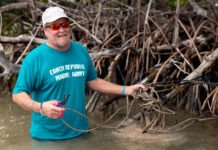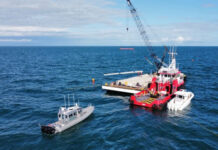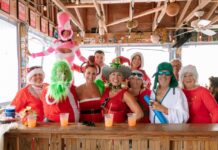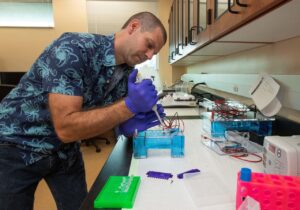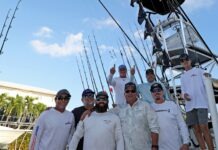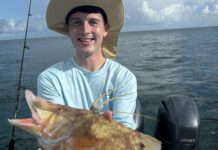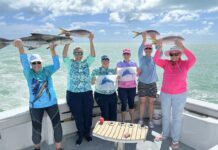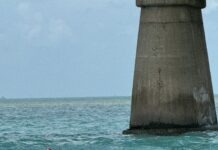
Now that we are getting into the windy cooler months, it’s time to start fishing the bridges more and more. At this time of year, many charters are scheduled for offshore, deep sea, big game trips, but sometimes Mother Nature has different plans in store. In this case we’ll tuck into our bridge spots and pull off a heck of a fishing trip that our clients will never forget. We can catch dozens of species this time of year, whether they’re table fare, a great fight, or memorable predators.
We target these bridge fish with live bait such as shrimp, pilchards, pinfish and mini mullet. Live shrimp is bait number one by far. We also fish with cut bait such as squid, chunks of ballyhoo and slivers of mullet and bonita bellies. When we fish with live shrimp, we use whatever size jig head will stay in the middle of the water column in the current. In other words, nothing so big that it immediately sinks to the bottom, and nothing so small that it won’t sink your bait in the rushing current. A heavy current means a heavier jig, with slack or slack-ish current calling for a smaller jig.
For example, if the current is running left or right from the bridge, cast out your jig hooked shrimp parallel to the bridge and work it back to the boat slowly. I like to use a combination of jigs and reels to make the retrieval somewhat sporadic. Sometimes the game fish just like the jigged shrimp to go with the flow.
It’s very important to hook your shrimp correctly. If you look on the internet “how to hook a live shrimp” you’ll see 100 different ways. Your shrimp should be hooked so when you retrieve it, it will be streamlined and hydro dynamic without “helicoptering.” We like to hook the live shrimp under its chin, up through its head and make the point of your hook flush with its horn. It’s important to miss its brains so the shrimp will stay lively. The shrimp’s head is transparent, and you can usually see its brains clearly.
When we fish the bridges, we like to chum a lot. In the fall we use an average of one block of chum per hour. Most bait shops in town sell chum by the box or by the case. One case of chum includes six boxes, so if we’re going out on a trip that’s six hours or less we’ll bring the whole case, and two cases if we’re going out longer. It’s better to have too much chum than not enough, and if you have leftovers at the end of the day, you can always stick them in your freezer for the next trip.
When anchoring at a bridge, I used to think it was better to anchor off the bridge and have your chum and hooked bait flowing toward the bridge. I found out years ago that in most cases, it’s better to anchor close to the bridge and have your chum and bait flowing away from the bridge. You catch just as many fish, and you don’t have as many fish breaking off by getting wrapped around the bridge pylons during the fight. Also, if you’re fishing into the bridge, and your anchor comes loose, your boat is floating toward the bridge. This can be dangerous, especially if you have a boat with a higher tower.


Speaking of potentially dangerous situations while bridge fishing – if you see a “Danger: Falling Debris” sign on the bridge, pay attention to it, because bridge debris really does fall from the bridge on occasion. Even though you don’t hear of it much, one day a big chunk of debris is going to fall off the bridge and take somebody out, especially around the un-renovated sections of the old Seven Mile Bridge. Just don’t anchor directly under it.
At the Seven Mile Bridge we like to target large snapper and grouper under the highest bridge span. We like mackerel and jacks near Fred the Tree, and most of our tarpon, shark and barracuda bridge fishing is on the extreme east side of the bridge at the entrance to Marathon near Sunset Grille. We like targeting bonefish and permit in the shallower water near Pigeon Key. We like to troll around Vaca Cut Bridge and catch snook and redfish near the Duck Key Bridge and Long Key Bridge.
Remember, when the weather is rough and you want to stay close to port and fish the bridge, the fish are running for cover too, and they hang around the bridges for shelter and food.
To book a charter with Ana Banana, call or text Capt. Joel at 813-267-4401 or Capt. Jojo at 305-879-0564, or visit anabananafishing.com.


